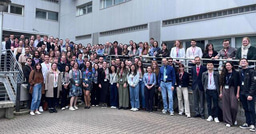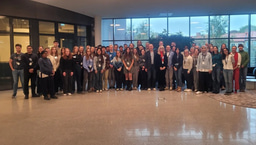Considering a postdoc? Read this first

There comes that moment in every graduate student’s career where “what’s next?” becomes less of a conversational question, and instead strikes panic. For me the realization that there had to be something “next” hit the Spring of 2022, as I was finishing up the analysis on the last big experiment of my thesis. I had always known that I wanted to do a postdoctoral fellowship, but it wasn’t until that point that I realized that I didn’t even know where to start finding one. So, I did the first thing I could think of, and that is also my first piece of advice for others…
1. Reach out to those around you
One important aspect to remember as a trainee is that those around you have been in your spot before. Your direct mentor, the PI down the hall, your program director, the dean, etc. As academics, a postdoctoral fellowship is common, if not required, before becoming an independent researcher. Therefore, those around you offer an excellent source of knowledge on what a postdoctoral fellowship is, and how to find one. For me, I turned to my thesis committee for advice and to get some ideas of where to begin the postdoctoral process. It was from the gracious advice of my committee members, made up of some junior faculty not far removed from the process, that I gathered the tips I am going to share here. These tips, combined, have successfully allowed me to secure a postdoctoral position tailored to my future goals.
2. Who cares who’s hiring
As is the case for most traditional jobs, I had early on assumed that recent grads secured a postdoctoral position by applying to openings listed on job boards. After very cursory searches in this avenue, I was finding that none of these openings really spoke to the work I wanted to do, or matched the career goals I had. I brought this up at a committee meeting and to my surprise I was informed that you don’t need to limit your scope to just those postdoc positions that have openings listed; in fact, it ended up being that NONE of the labs I applied to had openings listed at the time I reached out. But if I wasn’t applying to open positions, then how was I to find a postdoc? The answer to that question for me stated with…
3. Looking back at papers you’ve read and work you’ve admired
Quickly from the conversations with my committee members I learned that for my postdoctoral fellowships, the goal should be to find labs that you would be excited to work in. These are labs where you have been jealous of the work they are doing, the techniques they are using, and the career opportunities they are providing. Finding these labs may seem like a lot of work at first, but as graduate students we are constantly reading work from the field and adjacent fields, and in turn generating a repertoire of labs to investigate. For me, I went back through the papers I had read over the last 5 years picking out the ones where I highlighted 80% of the text, or the ones where my notes said “WOW” in every margin. I sorted through the manuscripts where the work excited me, and the methods were novel and mesmerizing. From this I started to identify labs whose research theme fitted with my future goals. I asked myself “Does this lab work on what I am interested in?” and “Would my current skill set complement their expertise?”. I looked for labs doing novel, exciting and well thought out research. From this I compiled a short list of labs – places where a postdoctoral fellowship would allow me to work on what I was interested in, learn new techniques, and grow within my field.
4. Make a list, check it twice
After compiling this short list, my next recommendation is to do a deep dive on those individuals, stalking the labs for any sort of online presence. For me, I first looked at the website of the lab to determine the size and structure. I looked for alumni members and where they were now. I then went to social media (primarily Twitter) to look for the lab and PIs presence. If they did have social media, I checked the tweets and interactions with other users. In some cases, I was even able to read interviews or listen to podcasts done by the PIs, from just a cursory Google search. All this gave me a first indication of the personalities that made up the labs. In one instance in particular, I reached out via Twitter to a former postdoc of a lab I was interested in, and I asked if they would share their experience, during which they shared that they would not recommend me reaching out to the PI. From these efforts I began to make that short list of potential PIs even shorter.
5. “Hi my name is…”
After compiling and cutting down my list, the most nerve wracking step in this process comes next, the actual reaching out the PIs at the forefront of the labs deemed highly desirable. For me, this began with rounds of “cold calling” via emailing and, to my surprise, I received an email back from every PI I reached out to in this manner. For me, success in this area came from the attention to detail I put into each email that I wrote. For every lab, I made sure to convey enthusiasm and passion for the research topic, often detailing which papers of theirs I was fascinated by, or recounting when/how I had first come across their work. In the cases where it was possible, I also tried to make any connection between my work, lab, or institution and their own. Included with each email I suggest attaching a personalized CV, detailing the most relevant skill sets for that specific opportunity, as well as alluding to future career plans. By including all of this in the first email, it allows the PIs to see everything at once, and eliminates the need for follow up emails or questions. I tried to make these emails as short as possible while hitting on all the above points. I assumed all PIs were busy, and it’s easier to read and reply to short emails. In my own hands, the previously mentioned steps combined with personalized emails, resulted in responses back from 100% of the labs I was interested in, followed by at least a Zoom interview from 80% of the labs.
6. Flip the tables!
One of the most important things to remember throughout this entire process is that you should also be interviewing the lab, looking for a place that fits your professional, scientific and personal goals. No matter how awkward it may seem, make sure you are taking time during the interview process to flip the script. Your thoughts on the lab and PI are just as important in this process as their thoughts about you. Take the time during interviews to get an idea of the culture, work-life balance, expectations, and mentorship you are going to receive, making sure that it lines up with your wants and needs.
7. Reach BACK out to those around you
Once you have some options on the table and are feeling confident with how your interviews have gone, my suggestion would be to reach back out to those around you. Now is the time to discuss the opportunities with those who know you best. At this stage, you are trying to figure out where the best fit will be. Leaning on those who have been there and experienced life as a postdoc can be really beneficial in helping you prioritize the different aspects of your options. It is great to hear first hand what parts of a postdoc were most important to those who have transitioned now to independent research.
8. Enjoy the process
Lastly, enjoy the process while you are in it. There will be a ton of people who you meet during the interview process, and you will get to experience a lot of really interesting research. Take the time to appreciate everything and connect with those around you. Even though you will only end up in one lab at the end of the day, this process can still be an awesome networking opportunity and a chance to build your academic circle.
While this list is by no means an extensive step-by-step guide to securing a postdoctoral position, it is meant to serve as a starting point for those who are beginning to think about their transition out of graduate school. These are the tips that were passed down to me personally by faculty at my graduate institution, and the steps that I took, ultimately allowing me to secure a postdoctoral fellowship right for my professional aspirations.
The above comments were provided by Dr. Ian Krout, a postdoctoral fellow at Emory University, Atlanta, USA, with guidance from Dr. Patrick Murphy, Assitant Professor at the University of Rochester, Rochester, New York, USA.
Photo by Alejandro Escamilla on Unsplash





Join the FEBS Network today
Joining the FEBS Network’s molecular life sciences community enables you to access special content on the site, present your profile, 'follow' contributors, 'comment' on and 'like' content, post your own content, and set up a tailored email digest for updates.